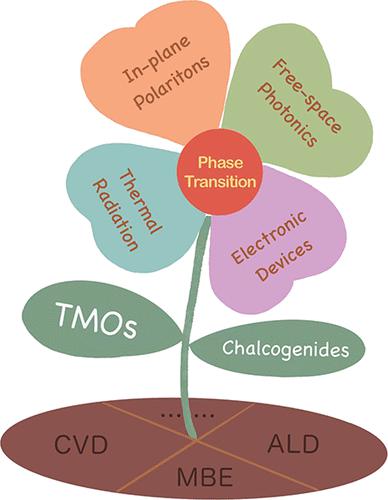当前位置:
X-MOL 学术
›
Chem. Rev.
›
论文详情
Our official English website, www.x-mol.net, welcomes your
feedback! (Note: you will need to create a separate account there.)
Enabling Active Nanotechnologies by Phase Transition: From Electronics, Photonics to Thermotics
Chemical Reviews ( IF 51.4 ) Pub Date : 2022-07-27 , DOI: 10.1021/acs.chemrev.2c00171 Chunqi Zheng 1, 2 , Robert E Simpson 3 , Kechao Tang 4 , Yujie Ke 3 , Arash Nemati 5 , Qing Zhang 6 , Guangwei Hu 1 , Chengkuo Lee 1 , Jinghua Teng 5 , Joel K W Yang 3, 5 , Junqiao Wu 7 , Cheng-Wei Qiu 1
Chemical Reviews ( IF 51.4 ) Pub Date : 2022-07-27 , DOI: 10.1021/acs.chemrev.2c00171 Chunqi Zheng 1, 2 , Robert E Simpson 3 , Kechao Tang 4 , Yujie Ke 3 , Arash Nemati 5 , Qing Zhang 6 , Guangwei Hu 1 , Chengkuo Lee 1 , Jinghua Teng 5 , Joel K W Yang 3, 5 , Junqiao Wu 7 , Cheng-Wei Qiu 1
Affiliation

|
Phase transitions can occur in certain materials such as transition metal oxides (TMOs) and chalcogenides when there is a change in external conditions such as temperature and pressure. Along with phase transitions in these phase change materials (PCMs) come dramatic contrasts in various physical properties, which can be engineered to manipulate electrons, photons, polaritons, and phonons at the nanoscale, offering new opportunities for reconfigurable, active nanodevices. In this review, we particularly discuss phase-transition-enabled active nanotechnologies in nonvolatile electrical memory, tunable metamaterials, and metasurfaces for manipulation of both free-space photons and in-plane polaritons, and multifunctional emissivity control in the infrared (IR) spectrum. The fundamentals of PCMs are first introduced to explain the origins and principles of phase transitions. Thereafter, we discuss multiphysical nanodevices for electronic, photonic, and thermal management, attesting to the broad applications and exciting promises of PCMs. Emerging trends and valuable applications in all-optical neuromorphic devices, thermal data storage, and encryption are outlined in the end.
中文翻译:

通过相变实现有源纳米技术:从电子学、光子学到热学
当温度和压力等外部条件发生变化时,某些材料(例如过渡金属氧化物 (TMO) 和硫属化物)会发生相变。随着这些相变材料 (PCM) 中的相变,各种物理特性也出现了巨大的对比,这些物理特性可以被设计成在纳米尺度上操纵电子、光子、极化子和声子,为可重构的有源纳米器件提供了新的机会。在这篇综述中,我们特别讨论了非易失性电存储器中的相变活性纳米技术、可调谐超材料和超表面,用于操纵自由空间光子和面内极化子,以及红外 (IR) 光谱中的多功能发射率控制。首先介绍 PCM 的基本原理来解释相变的起源和原理。此后,我们讨论了用于电子、光子和热管理的多物理纳米器件,证明了 PCM 的广泛应用和令人兴奋的前景。最后概述了全光学神经形态设备、热数据存储和加密中的新兴趋势和有价值的应用。
更新日期:2022-07-27
中文翻译:

通过相变实现有源纳米技术:从电子学、光子学到热学
当温度和压力等外部条件发生变化时,某些材料(例如过渡金属氧化物 (TMO) 和硫属化物)会发生相变。随着这些相变材料 (PCM) 中的相变,各种物理特性也出现了巨大的对比,这些物理特性可以被设计成在纳米尺度上操纵电子、光子、极化子和声子,为可重构的有源纳米器件提供了新的机会。在这篇综述中,我们特别讨论了非易失性电存储器中的相变活性纳米技术、可调谐超材料和超表面,用于操纵自由空间光子和面内极化子,以及红外 (IR) 光谱中的多功能发射率控制。首先介绍 PCM 的基本原理来解释相变的起源和原理。此后,我们讨论了用于电子、光子和热管理的多物理纳米器件,证明了 PCM 的广泛应用和令人兴奋的前景。最后概述了全光学神经形态设备、热数据存储和加密中的新兴趋势和有价值的应用。


















































 京公网安备 11010802027423号
京公网安备 11010802027423号